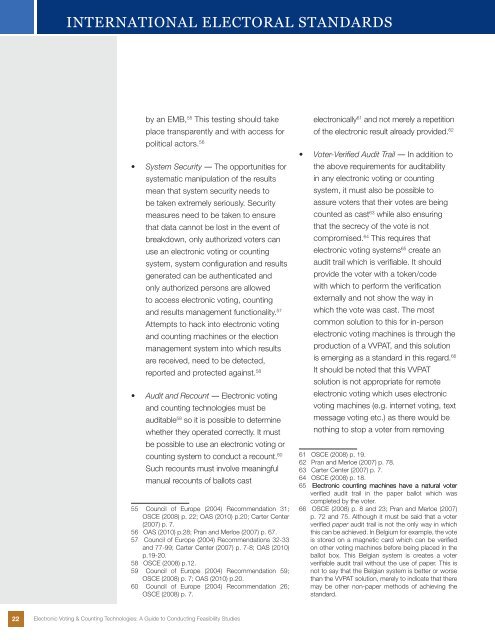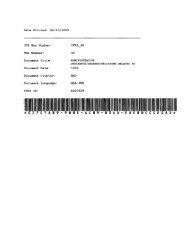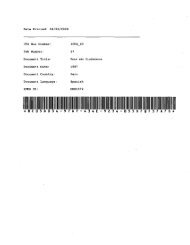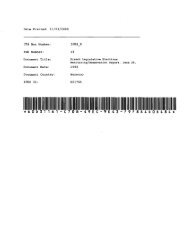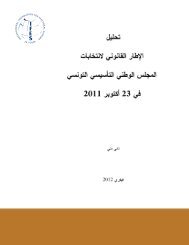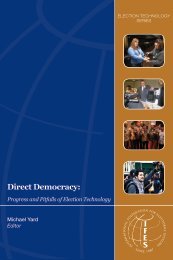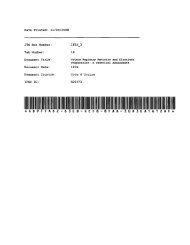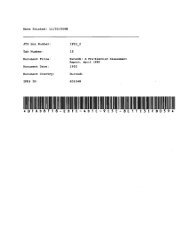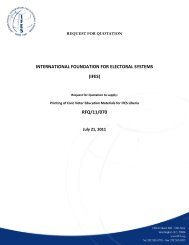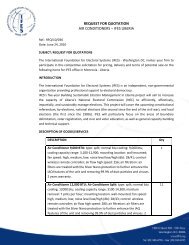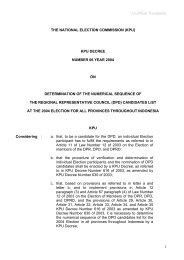Electronic Voting & Counting Technologies - IFES
Electronic Voting & Counting Technologies - IFES
Electronic Voting & Counting Technologies - IFES
- No tags were found...
You also want an ePaper? Increase the reach of your titles
YUMPU automatically turns print PDFs into web optimized ePapers that Google loves.
INTERNATIONAL ELECTORAL STANDARDSby an EMB, 55 This testing should takeplace transparently and with access forpolitical actors. 56• System Security — The opportunities forsystematic manipulation of the resultsmean that system security needs tobe taken extremely seriously. Securitymeasures need to be taken to ensurethat data cannot be lost in the event ofbreakdown, only authorized voters canuse an electronic voting or countingsystem, system configuration and resultsgenerated can be authenticated andonly authorized persons are allowedto access electronic voting, countingand results management functionality. 57Attempts to hack into electronic votingand counting machines or the electionmanagement system into which resultsare received, need to be detected,reported and protected against. 58• Audit and Recount — <strong>Electronic</strong> votingand counting technologies must beauditable 59 so it is possible to determinewhether they operated correctly. It mustbe possible to use an electronic voting orcounting system to conduct a recount. 60Such recounts must involve meaningfulmanual recounts of ballots cast55 Council of Europe (2004) Recommendation 31;OSCE (2008) p. 22; OAS (2010) p.20; Carter Center(2007) p. 7.56 OAS (2010) p.28; Pran and Merloe (2007) p. 67.57 Council of Europe (2004) Recommendations 32-33and 77-99; Carter Center (2007) p. 7-8; OAS (2010)p.19-20.58 OSCE (2008) p.12.59 Council of Europe (2004) Recommendation 59;OSCE (2008) p. 7; OAS (2010) p.20.60 Council of Europe (2004) Recommendation 26;OSCE (2008) p. 7.electronically 61 and not merely a repetitionof the electronic result already provided. 62• Voter-Verified Audit Trail — In addition tothe above requirements for auditabilityin any electronic voting or countingsystem, it must also be possible toassure voters that their votes are beingcounted as cast 63 while also ensuringthat the secrecy of the vote is notcompromised. 64 This requires thatelectronic voting systems 65 create anaudit trail which is verifiable. It shouldprovide the voter with a token/codewith which to perform the verificationexternally and not show the way inwhich the vote was cast. The mostcommon solution to this for in-personelectronic voting machines is through theproduction of a VVPAT, and this solutionis emerging as a standard in this regard. 66It should be noted that this VVPATsolution is not appropriate for remoteelectronic voting which uses electronicvoting machines (e.g. internet voting, textmessage voting etc.) as there would benothing to stop a voter from removing61 OSCE (2008) p. 19.62 Pran and Merloe (2007) p. 78.63 Carter Center (2007) p. 7.64 OSCE (2008) p. 18.65 <strong>Electronic</strong> counting machines have a natural voterverified audit trail in the paper ballot which wascompleted by the voter.66 OSCE (2008) p. 8 and 23; Pran and Merloe (2007)p. 72 and 75. Although it must be said that a voterverified paper audit trail is not the only way in whichthis can be achieved. In Belgium for example, the voteis stored on a magnetic card which can be verifiedon other voting machines before being placed in theballot box. This Belgian system is creates a voterverifiable audit trail without the use of paper. This isnot to say that the Belgian system is better or worsethan the VVPAT solution, merely to indicate that theremay be other non-paper methods of achieving thestandard.22<strong>Electronic</strong> <strong>Voting</strong> & <strong>Counting</strong> <strong>Technologies</strong>: A Guide to Conducting Feasibility Studies


